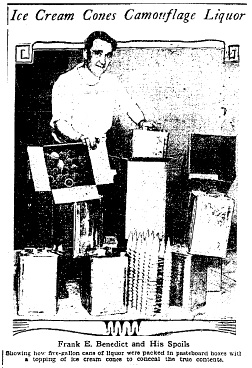July 10, 1927
Los Angeles
First peanuts and now the All-American ice cream cone. Is there no treat safe from the bootlegger’s evil maw? Assistant Federal prohibition administrator Frank E. Benedict today announced the discovery of what was called "one of the most completely equipped distilleries" ever found in Los Angeles, hidden in the innocent guise of an ice cream cone factory.
A curious fact brought the plant (located at 354-1/2 West Manchester Avenue) to the attention of eagle-eyed prohibition agents: business appeared to be flourishing, yet no deliveries were seen leaving the building. Further investigation ensued. When proprietor James Kanich was informed that the interior measurements of the shop matched those he previously provided to agents, his response was "a flippant remark" that led Benedict to measure the building’s exterior as well. A twenty-three foot discrepancy was thus discovered. Benedict returned inside, sounded the wall with a hammer, found a weak spot, and chopped into the wallboard. Behind it stood a 500-gallon still in full operation. Four thousand gallons of mash were ready for use at the top of a nearby stairway, and forty five-gallon cans of grain alcohol were packed in heavy paper cartons ostensibly used for freshly baked ice cream cones. The distilling room was accessible only through a narrow closet door which, when closed, appeared to be a solid wall. Meanwhile, a thorough check of the main building yielded stale ice cream cones and cone-making machinery filled with cobwebs.
Both Kanich and his wife, Mary, denied knowledge of the still. Mrs. Kanich told agents that she and her husband were the innocent victims of a group who financed the cone factory, led by a man she could identify only as "Harry."
The Kaniches were arrested for violation of the Volstead Act. Benedict promised further arrests would be made.



